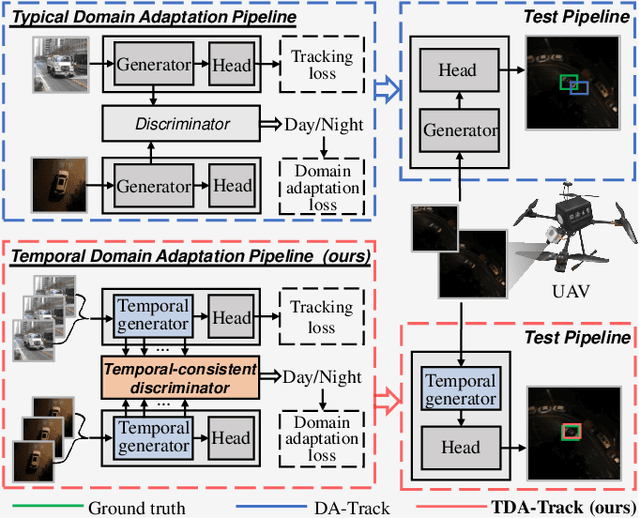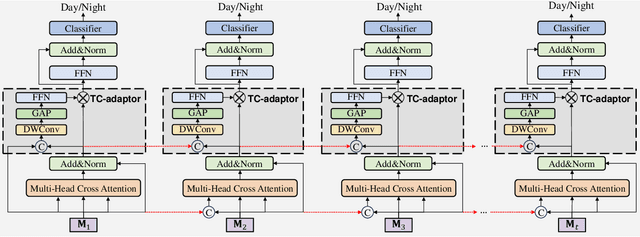Liangliang Yao
AnyTSR: Any-Scale Thermal Super-Resolution for UAV
Apr 18, 2025Abstract:Thermal imaging can greatly enhance the application of intelligent unmanned aerial vehicles (UAV) in challenging environments. However, the inherent low resolution of thermal sensors leads to insufficient details and blurred boundaries. Super-resolution (SR) offers a promising solution to address this issue, while most existing SR methods are designed for fixed-scale SR. They are computationally expensive and inflexible in practical applications. To address above issues, this work proposes a novel any-scale thermal SR method (AnyTSR) for UAV within a single model. Specifically, a new image encoder is proposed to explicitly assign specific feature code to enable more accurate and flexible representation. Additionally, by effectively embedding coordinate offset information into the local feature ensemble, an innovative any-scale upsampler is proposed to better understand spatial relationships and reduce artifacts. Moreover, a novel dataset (UAV-TSR), covering both land and water scenes, is constructed for thermal SR tasks. Experimental results demonstrate that the proposed method consistently outperforms state-of-the-art methods across all scaling factors as well as generates more accurate and detailed high-resolution images. The code is located at https://github.com/vision4robotics/AnyTSR.
DaDiff: Domain-aware Diffusion Model for Nighttime UAV Tracking
Oct 16, 2024Abstract:Domain adaptation is an inspiring solution to the misalignment issue of day/night image features for nighttime UAV tracking. However, the one-step adaptation paradigm is inadequate in addressing the prevalent difficulties posed by low-resolution (LR) objects when viewed from the UAVs at night, owing to the blurry edge contour and limited detail information. Moreover, these approaches struggle to perceive LR objects disturbed by nighttime noise. To address these challenges, this work proposes a novel progressive alignment paradigm, named domain-aware diffusion model (DaDiff), aligning nighttime LR object features to the daytime by virtue of progressive and stable generations. The proposed DaDiff includes an alignment encoder to enhance the detail information of nighttime LR objects, a tracking-oriented layer designed to achieve close collaboration with tracking tasks, and a successive distribution discriminator presented to distinguish different feature distributions at each diffusion timestep successively. Furthermore, an elaborate nighttime UAV tracking benchmark is constructed for LR objects, namely NUT-LR, consisting of 100 annotated sequences. Exhaustive experiments have demonstrated the robustness and feature alignment ability of the proposed DaDiff. The source code and video demo are available at https://github.com/vision4robotics/DaDiff.
Prompt-Driven Temporal Domain Adaptation for Nighttime UAV Tracking
Sep 27, 2024



Abstract:Nighttime UAV tracking under low-illuminated scenarios has achieved great progress by domain adaptation (DA). However, previous DA training-based works are deficient in narrowing the discrepancy of temporal contexts for UAV trackers. To address the issue, this work proposes a prompt-driven temporal domain adaptation training framework to fully utilize temporal contexts for challenging nighttime UAV tracking, i.e., TDA. Specifically, the proposed framework aligns the distribution of temporal contexts from daytime and nighttime domains by training the temporal feature generator against the discriminator. The temporal-consistent discriminator progressively extracts shared domain-specific features to generate coherent domain discrimination results in the time series. Additionally, to obtain high-quality training samples, a prompt-driven object miner is employed to precisely locate objects in unannotated nighttime videos. Moreover, a new benchmark for long-term nighttime UAV tracking is constructed. Exhaustive evaluations on both public and self-constructed nighttime benchmarks demonstrate the remarkable performance of the tracker trained in TDA framework, i.e., TDA-Track. Real-world tests at nighttime also show its practicality. The code and demo videos are available at https://github.com/vision4robotics/TDA-Track.
Progressive Representation Learning for Real-Time UAV Tracking
Sep 25, 2024



Abstract:Visual object tracking has significantly promoted autonomous applications for unmanned aerial vehicles (UAVs). However, learning robust object representations for UAV tracking is especially challenging in complex dynamic environments, when confronted with aspect ratio change and occlusion. These challenges severely alter the original information of the object. To handle the above issues, this work proposes a novel progressive representation learning framework for UAV tracking, i.e., PRL-Track. Specifically, PRL-Track is divided into coarse representation learning and fine representation learning. For coarse representation learning, two innovative regulators, which rely on appearance and semantic information, are designed to mitigate appearance interference and capture semantic information. Furthermore, for fine representation learning, a new hierarchical modeling generator is developed to intertwine coarse object representations. Exhaustive experiments demonstrate that the proposed PRL-Track delivers exceptional performance on three authoritative UAV tracking benchmarks. Real-world tests indicate that the proposed PRL-Track realizes superior tracking performance with 42.6 frames per second on the typical UAV platform equipped with an edge smart camera. The code, model, and demo videos are available at \url{https://github.com/vision4robotics/PRL-Track}.
Enhancing Nighttime UAV Tracking with Light Distribution Suppression
Sep 25, 2024Abstract:Visual object tracking has boosted extensive intelligent applications for unmanned aerial vehicles (UAVs). However, the state-of-the-art (SOTA) enhancers for nighttime UAV tracking always neglect the uneven light distribution in low-light images, inevitably leading to excessive enhancement in scenarios with complex illumination. To address these issues, this work proposes a novel enhancer, i.e., LDEnhancer, enhancing nighttime UAV tracking with light distribution suppression. Specifically, a novel image content refinement module is developed to decompose the light distribution information and image content information in the feature space, allowing for the targeted enhancement of the image content information. Then this work designs a new light distribution generation module to capture light distribution effectively. The features with light distribution information and image content information are fed into the different parameter estimation modules, respectively, for the parameter map prediction. Finally, leveraging two parameter maps, an innovative interweave iteration adjustment is proposed for the collaborative pixel-wise adjustment of low-light images. Additionally, a challenging nighttime UAV tracking dataset with uneven light distribution, namely NAT2024-2, is constructed to provide a comprehensive evaluation, which contains 40 challenging sequences with over 74K frames in total. Experimental results on the authoritative UAV benchmarks and the proposed NAT2024-2 demonstrate that LDEnhancer outperforms other SOTA low-light enhancers for nighttime UAV tracking. Furthermore, real-world tests on a typical UAV platform with an NVIDIA Orin NX confirm the practicality and efficiency of LDEnhancer. The code is available at https://github.com/vision4robotics/LDEnhancer.
Conditional Generative Denoiser for Nighttime UAV Tracking
Sep 25, 2024Abstract:State-of-the-art (SOTA) visual object tracking methods have significantly enhanced the autonomy of unmanned aerial vehicles (UAVs). However, in low-light conditions, the presence of irregular real noise from the environments severely degrades the performance of these SOTA methods. Moreover, existing SOTA denoising techniques often fail to meet the real-time processing requirements when deployed as plug-and-play denoisers for UAV tracking. To address this challenge, this work proposes a novel conditional generative denoiser (CGDenoiser), which breaks free from the limitations of traditional deterministic paradigms and generates the noise conditioning on the input, subsequently removing it. To better align the input dimensions and accelerate inference, a novel nested residual Transformer conditionalizer is developed. Furthermore, an innovative multi-kernel conditional refiner is designed to pertinently refine the denoised output. Extensive experiments show that CGDenoiser promotes the tracking precision of the SOTA tracker by 18.18\% on DarkTrack2021 whereas working 5.8 times faster than the second well-performed denoiser. Real-world tests with complex challenges also prove the effectiveness and practicality of CGDenoiser. Code, video demo and supplementary proof for CGDenoier are now available at: \url{https://github.com/vision4robotics/CGDenoiser}.
SAM-DA: UAV Tracks Anything at Night with SAM-Powered Domain Adaptation
Jul 03, 2023Abstract:Domain adaptation (DA) has demonstrated significant promise for real-time nighttime unmanned aerial vehicle (UAV) tracking. However, the state-of-the-art (SOTA) DA still lacks the potential object with accurate pixel-level location and boundary to generate the high-quality target domain training sample. This key issue constrains the transfer learning of the real-time daytime SOTA trackers for challenging nighttime UAV tracking. Recently, the notable Segment Anything Model (SAM) has achieved remarkable zero-shot generalization ability to discover abundant potential objects due to its huge data-driven training approach. To solve the aforementioned issue, this work proposes a novel SAM-powered DA framework for real-time nighttime UAV tracking, i.e., SAM-DA. Specifically, an innovative SAM-powered target domain training sample swelling is designed to determine enormous high-quality target domain training samples from every single raw nighttime image. This novel one-to-many method significantly expands the high-quality target domain training sample for DA. Comprehensive experiments on extensive nighttime UAV videos prove the robustness and domain adaptability of SAM-DA for nighttime UAV tracking. Especially, compared to the SOTA DA, SAM-DA can achieve better performance with fewer raw nighttime images, i.e., the fewer-better training. This economized training approach facilitates the quick validation and deployment of algorithms for UAVs. The code is available at https://github.com/vision4robotics/SAM-DA.
SGDViT: Saliency-Guided Dynamic Vision Transformer for UAV Tracking
Mar 08, 2023Abstract:Vision-based object tracking has boosted extensive autonomous applications for unmanned aerial vehicles (UAVs). However, the dynamic changes in flight maneuver and viewpoint encountered in UAV tracking pose significant difficulties, e.g. , aspect ratio change, and scale variation. The conventional cross-correlation operation, while commonly used, has limitations in effectively capturing perceptual similarity and incorporates extraneous background information. To mitigate these limitations, this work presents a novel saliency-guided dynamic vision Transformer (SGDViT) for UAV tracking. The proposed method designs a new task-specific object saliency mining network to refine the cross-correlation operation and effectively discriminate foreground and background information. Additionally, a saliency adaptation embedding operation dynamically generates tokens based on initial saliency, thereby reducing the computational complexity of the Transformer architecture. Finally, a lightweight saliency filtering Transformer further refines saliency information and increases the focus on appearance information. The efficacy and robustness of the proposed approach have been thoroughly assessed through experiments on three widely-used UAV tracking benchmarks and real-world scenarios, with results demonstrating its superiority. The source code and demo videos are available at https://github.com/vision4robotics/SGDViT.
 Add to Chrome
Add to Chrome Add to Firefox
Add to Firefox Add to Edge
Add to Edge